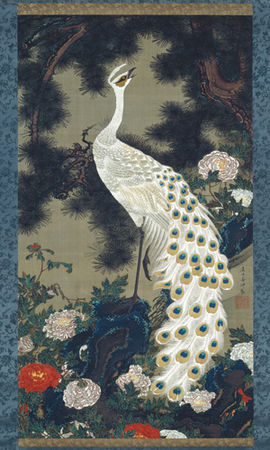"Colorful Realm: Japanese Bird-and-Flower Paintings by Itō Jakuchū (1716–1800)" @ NGA Washington
Colorful Realm of Living Beings, by Itō Jakuchū © 2012 National Gallery of Art, Washington, DC
Celebrating the centennial of Japan's gift of cherry trees to the nation's capital, this exhibition features one of Japan's most renowned cultural treasures, the 30-scroll set of bird-and-flower paintings by Itō Jakuchū. Titled Colorful Realm of Living Beings(J. Dōshoku sai-e; c. 1757–1766), these extraordinary scrolls are being lent to the National Gallery of Art by the Imperial Household. Their exhibition here—for one month only—provides a unique, once-in-a-lifetime opportunity: not only is it the first time all 30 paintings will be on view in the United States, but it is also the first time any of the works will be seen here after their six-year-long restoration.
Colorful Realm of Living Beings, by Itō Jakuchū © 2012 National Gallery of Art, Washington, DC
Colorful Realm stands as the most dynamic and comprehensive—yet meditative and distilled—expression of the natural world in all of Japanese art. Synthesizing numerous East Asian traditions of bird-and-flower painting, the set depicts each of its 30 subjects in wondrously meticulous detail, but in such a way as to transcend surface appearances and capture the otherwise ineffable, vital essence of the cosmos, the Buddha nature itself. To present the full significance of Colorful Realm, the exhibition and its catalogue reunite this masterpiece with Jakuchū's triptych of the Buddha Śākyamuni from the Zen monastery Shōkokuji in Kyoto. Jakuchū had donated both works to the monastery, which displayed them in a large temple room during Buddhist rituals.
Colorful Realm of Living Beings, by Itō Jakuchū © 2012 National Gallery of Art, Washington, DC
Recent conservation of Colorful Realm has generated an entirely new awareness of the material profile of the set and the technical means by which Jakuchū created each scroll. Drawing upon these findings as well as the most recent research on Jakuchū's life and cultural environment, this exhibition offers a multifaceted understanding of the artist's virtuosity and experimentalism as a painter—one who not only applied sophisticated chromatic effects but also masterfully rendered the richly symbolic world in which he moved.
Colorful Realm of Living Beings, by Itō Jakuchū © 2012 National Gallery of Art, Washington, DC
The earliest of the 30 scrolls, Peonies and Butterflies, combines two subjects that enjoyed great popularity in East Asian pictorial traditions. On the one hand, the peony flower was likened to both feminine beauty and prosperity. It became the preferred garden flower of the imperial and aristocratic elite during China's Tang dynasty (618–907) and at the court of Emperor Xuanzong in particular; in East Asian literary traditions Li Bai's verse likening the beauty of Xuanzong's favorite consort Yang Guifei (719–756) to a peony cemented the flower's association with feminine beauty. Meanwhile, its full and gorgeous appearance lent itself to uncomplicated associations with affluence and good fortune. The butterfly also served as an auspicious symbol, though its popularity was equally attributable to its appearance in one of the most famous parables in early Chinese thought: Zhuangzi's dream of a butterfly. According to this parable, the legendary sage Zhuangzi dreams that he is a carefree yellow butterfly. Upon awakening, however, "he didn't know if he was Zhuangzi who had dreamt he was a butterfly, or a butterfly dreaming he was Zhuangzi." Paintings of butterflies inevitably invoked the oneiric setting and queried selfhood of the Zhuangzi anecdote in most East Asian contexts and particularly in Jakuchū's circle of erudite Sinophile monks, scholars, and merchants. While visually opulent, Peonies and Butterflies also suggests the uncertainty of a just-awoken dreamer who momentarily confuses reverie with reality.
Colorful Realm of Living Beings, by Itō Jakuchū © 2012 National Gallery of Art, Washington, DC
Careful study of the painting's pigmentation points to Jakuchū's remarkable distillation and intensification of traditional East Asian coloration techniques. Different grades of opacity and transparency are achieved in the butterflies, flowers, stems, and leaves by varying the use of mineral and vegetal pigments, occasionally layering them one on top of another and adding a sublayer of color on the back of the silk. This complex stratigraphy of colors results in a convincing imbrication of the motifs in their surroundings. Indeed, when Jakuchū's cultural and spiritual mentor Daiten (1719–1801) encountered the painting in 1760, he titled it "Beautiful Mist and Fragrant Wind" (Enka kōfū), suggesting that the real subject here was not the peonies and butterflies, but the conceptual atmosphere that enveloped them, the invisible ether within which they swayed and glided.
Colorful Realm of Living Beings, by Itō Jakuchū © 2012 National Gallery of Art, Washington, DC
Colorful Realm of Living Beings, by Itō Jakuchū © 2012 National Gallery of Art, Washington, DC
Colorful Realm of Living Beings, by Itō Jakuchū © 2012 National Gallery of Art, Washington, DC

/https%3A%2F%2Fprofilepics.canalblog.com%2Fprofilepics%2F1%2F0%2F100183.jpg)
/https%3A%2F%2Fstorage.canalblog.com%2F03%2F02%2F119589%2F96711876_o.jpg)
/https%3A%2F%2Fstorage.canalblog.com%2F11%2F31%2F119589%2F94773502_o.jpg)
/https%3A%2F%2Fstorage.canalblog.com%2F20%2F83%2F119589%2F94772815_o.jpg)
/https%3A%2F%2Fstorage.canalblog.com%2F26%2F72%2F119589%2F75604929_o.jpg)
/https%3A%2F%2Fstorage.canalblog.com%2F59%2F60%2F119589%2F26458628_o.jpg)










/http%3A%2F%2Fstorage.canalblog.com%2F56%2F68%2F119589%2F121314056_o.jpg)
/http%3A%2F%2Fstorage.canalblog.com%2F94%2F26%2F119589%2F93499813_o.jpg)
/http%3A%2F%2Fstorage.canalblog.com%2F47%2F99%2F119589%2F31390621_o.jpg)
/http%3A%2F%2Fstorage.canalblog.com%2F34%2F76%2F119589%2F72678044_o.jpg)